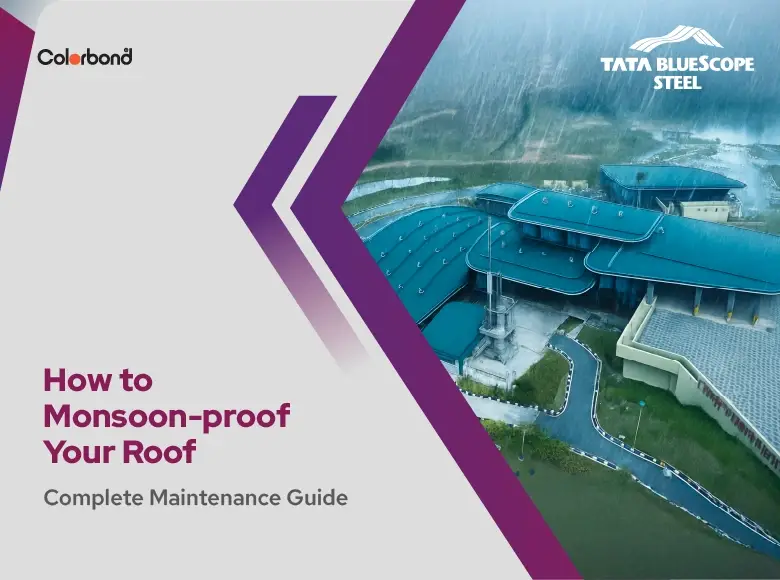
When the skies darken and the air gets heavier, it’s a clear sign – the monsoon is on its way. And as always, monsoon readiness begins at the top: your roof. Often, the first line of defence against heavy rain, humidity, and wind, your roofing system plays a critical role in protecting the entire structure beneath it.
To ensure uninterrupted performance through the season, timely upkeep and smart planning go a long way. With the right roofing solutions, regular inspection, and thoughtful maintenance, you can prepare your structure to face the rains with confidence.
Whether you’re a homeowner, contractor, or facility manager, this guide covers essential roof maintenance tips to help you achieve monsoon-proof roofing.
Monsoon Readiness Starts at the Top
Heavy rain, humidity, and fluctuating temperatures can accelerate wear and tear on your roof. From water seepage to fastener loosening, minor issues can quickly develop into expensive repairs. Preparing in advance saves money, ensures safety, and offers peace of mind during the monsoon.
Today, modern solutions such as weather-resistant roofing provide a long-lasting, durable option for monsoon zones. But even the most advanced roofing systems benefit from regular care. Proactive maintenance ensures that your durable roofing solutions for monsoon continue to perform optimally year after year.
Why Preventive Roofing Maintenance Matters
Routine maintenance is about more than just appearances; it’s also about functionality. Preventive care helps detect and resolve early signs of deterioration before they escalate. Especially during monsoon, when rainfall tests every joint, slope, and surface, having a water-resistant, well-maintained roof becomes essential. The following steps ensure great resilience when complemented with proper maintenance practices.
1. Inspect for Cracks & Leak Points
Begin your monsoon prep with a thorough visual inspection of the roof surface. Look for cracks, open seams, or puncture marks that could lead to water intrusion.
Focus areas for inspection:
- Roof valleys and joints
- Around skylights or vents
- Seams where roofing panels meet
Hairline cracks or sealant gaps may appear harmless, but can quickly become leak channels during heavy rain. Apply appropriate waterproofing sealants or flashing tapes wherever needed. For added protection, water-resistant roofing materials like COLORBOND® steel roofing provide a secure, leak-resistant base, especially when installed and maintained with attention to detailing.
2. Clean Gutters & Downpipes
One of the most common causes of water backup and seepage is blocked drainage. Monsoon showers can quickly flood roofs with leaves, dirt, and debris that clog gutters and downpipes.
Tips to prepare:
- Clear all dried leaves, twigs, and silt from gutter trays
- Flush downpipes with water to ensure free flow
- Install wire mesh guards over gutters to prevent further debris accumulation
When combined with roofing solutions designed for seamless water flow, like those integrated into COLORBOND® steel roofing, a clean drainage system ensures that water flows off efficiently, reducing the risk of damage.
3. Check Roof Fasteners & Flashings
Even the strongest materials require secure installation. Loose or corroded fasteners and damaged flashings can compromise your roof’s ability to resist weather.
Here’s what to do:
- Tighten loose screws and nuts
- Inspect overlaps and joints for rust marks or displacement
- Check if flashings at roof edges and corners are sealed properly
Over time, metal expansion and contraction may loosen fasteners. Ensuring they are snug before the rains helps in reinforcing the roof’s integrity. With weather-resistant roofing with COLORBOND® steel, installation with high-grade accessories further enhances long-term performance, especially in monsoon-prone regions.
4. Look for Fungus or Mold
Humidity provides the perfect environment for algae, moss, and fungal growth, especially on shaded or damp parts of the roof. These can lead to structural degradation and slippery surfaces.
How to address this:
- Use a long-handled brush and mild cleaning solution to scrub away early signs
- Apply antifungal coatings where needed
- Ensure proper ventilation to reduce moisture buildup
COLORBOND® steel roofing features specialized coatings that resist fungal and mold growth, reducing surface damage. However, keeping the surface clean and dry ensures your monsoon-proof roofing remains safe and functional.
5. Evaluate Roof Slope & Drainage
The slope of your roof plays a vital role in guiding rainwater away. Flat or low-slope roofs may suffer from water pooling, which can eventually lead to structural damage.
Here’s what to check:
- Identify any sections where water tends to stagnate
- Ensure the slope allows gravity-driven drainage toward gutters
- If needed, install crickets or slope-enhancing layers to redirect water
When combined with durable roofing solutions for monsoon-like COLORBOND® steel, a well-designed slope minimizes the risk of leakage, extends the roof life, and promotes faster drying after rainfall.
Conclusion: A Roof That’s Monsoon-Ready Protects More Than Just the Building
Monsoon weather is a true test of your roof’s design, materials, and maintenance. Preparing for it in advance helps you avoid disruptions, reduces emergency repair costs, and protects interiors from weather-related damage.
Solutions like COLORBOND® steel roofing are engineered for high performance in extreme weather, with protective coatings that resist corrosion, peeling, cracking and mold growth. Their robust build and minimal maintenance requirements make them especially suitable for monsoon-prone regions. With COLORBOND® steel, you can be assured of reliable performance and peace of mind during the rainy season, with far less need for frequent intervention.
So, whether it’s clearing gutters, sealing joints, or evaluating slope design – each step plays a role in achieving monsoon-proof roofing. With dependable systems like COLORBOND® steel roofing, paired with regular upkeep, you can stay safe, dry, and worry-free through every downpour. Get in touch with us to know how COLORBOND® steel roofing can be the best choice to keep your roof monsoon-ready.
